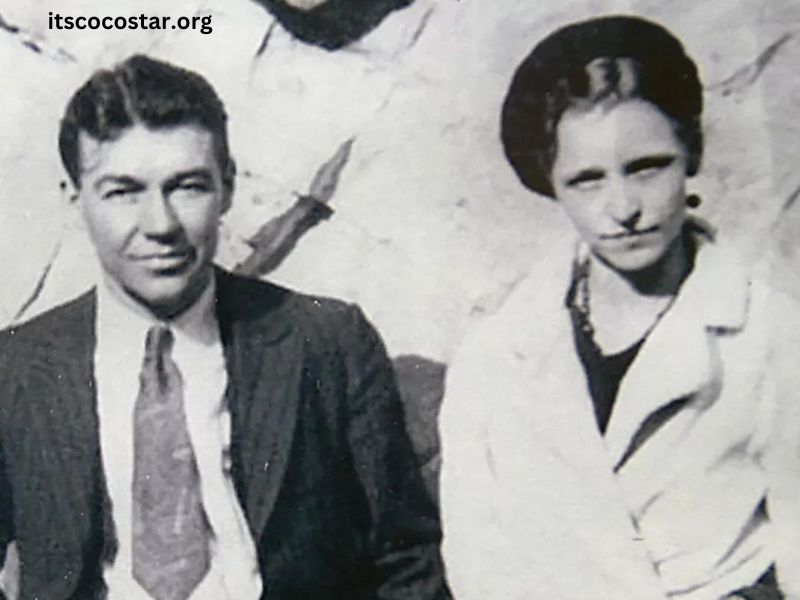The story of Bonnie Parker and Clyde Barrow, notorious criminals of the Great Depression era, has been immortalized in American folklore, pop culture, and history books. Their story, full of drama, violence, and romance, culminated in a violent death that was captured in a series of haunting photographs. These images have continued to captivate the public’s imagination, serving as a chilling reminder of the brutal end of a life lived on the edge of the law.
The Rise of Bonnie and Clyde
Bonnie Parker and Clyde Barrow were young, passionate, and deeply entwined in a life of crime. Born during the early 20th century in Texas, both Bonnie and Clyde came from impoverished backgrounds, which, in part, influenced their turn to crime. Clyde Barrow, born in 1909, began his criminal career early, committing small-time robberies before escalating to more serious crimes. Bonnie Parker, born in 1910, had a more traditional upbringing, but her life took a dramatic turn when she met Clyde in 1930. The two quickly fell in love, and Bonnie became Clyde’s loyal companion and accomplice.
Their crime spree began in 1932, and over the next two years, they became infamous for their robberies, car thefts, and shootouts with law enforcement across multiple states. Their exploits were sensationalized by the media, which often portrayed them as modern-day Robin Hoods, albeit without the altruistic motives. This romanticized image was, however, far from the truth. Bonnie and Clyde’s crimes were often violent, and they left a trail of devastation and death in their wake.
The Ambush and Death of Bonnie and Clyde
As Bonnie and Clyde’s crime spree continued, law enforcement across the country intensified efforts to apprehend the duo. Their luck finally ran out on May 23, 1934, when they were ambushed by a posse of law enforcement officers in Bienville Parish, Louisiana. Led by Texas Ranger Frank Hamer, the posse had been tracking Bonnie and Clyde for months and finally set a trap on a rural road near Gibsland, Louisiana.
On the morning of May 23, Bonnie and Clyde were driving along the rural road in their stolen 1934 Ford Deluxe when they encountered a truck that appeared to be broken down. As they slowed down to offer assistance, the posse, hidden in the bushes along the roadside, opened fire. The ambush was swift and brutal. In just a matter of seconds, the officers fired over 130 rounds into the vehicle, killing Bonnie and Clyde instantly. Their bodies were riddled with bullets, and the car was left a mangled wreck.
The Aftermath: Death Scene Photos
In the aftermath of the ambush, law enforcement officers and local residents quickly swarmed the scene. It was not long before photographers arrived to capture the aftermath, leading to the creation of some of the most iconic and gruesome images in American criminal history. The death scene photos of Bonnie and Clyde, lying lifeless in their car, their bodies riddled with bullets, have become synonymous with their story and serve as a stark contrast to the romanticized image that had been cultivated by the media during their crime spree.
The photos depict a chaotic scene. Bonnie’s body is slumped over in the passenger seat, her head leaning against the door, while Clyde is slouched behind the wheel, his foot still on the accelerator. The car, a symbol of their freedom and mobility, is riddled with bullet holes, its windows shattered, and its once shiny exterior covered in blood and dust. These images captured the gruesome reality of their violent end and quickly circulated in newspapers across the country, further cementing their legend.
The Public’s Reaction
The death scene photos of Bonnie and Clyde had a profound impact on the public. For some, the images elicited a sense of justice served, a conclusion to the reign of terror that Bonnie and Clyde had inflicted on the Midwest. The photographs were a stark reminder of the inevitable fate of those who choose a life of crime, a message that was not lost on the American public during the harsh economic times of the Great Depression.
However, the photos also contributed to the mythologization of Bonnie and Clyde. The brutal nature of their deaths, captured so vividly in the images, added to the tragic romance that had surrounded them. In death, Bonnie and Clyde became martyrs of a sort, symbolic of the desperation and defiance of the era. The photos, with their raw and unfiltered portrayal of the aftermath, immortalized Bonnie and Clyde in a way that few criminals before or since have been.
Legacy of the Death Scene Photos
The photos taken on that fateful day in Louisiana have had a lasting impact on both the legacy of Bonnie and Clyde and the public’s fascination with crime and punishment. Over the decades, these images have been reproduced countless times in books, documentaries, and films, each time reinforcing the narrative of Bonnie and Clyde as tragic anti-heroes.
One of the most significant cultural impacts of the death scene photos came with the release of the 1967 film “Bonnie and Clyde,” directed by Arthur Penn and starring Faye Dunaway and Warren Beatty. The film, which was groundbreaking in its depiction of violence, drew heavily on the imagery of the real-life ambush and death of Bonnie and Clyde. The final scene of the film, which graphically portrays the ambush, mirrors the gruesome reality captured in the original photos. The film’s success brought the story of Bonnie and Clyde to a new generation, ensuring that their legacy would continue to be a part of American pop culture.
Beyond their influence on popular culture, the death scene photos also had an impact on law enforcement practices. The ambush of Bonnie and Clyde, and the subsequent public interest in the photos, highlighted the growing role of the media in shaping public perceptions of crime and justice. The widespread distribution of the photos demonstrated the power of visual media to influence public opinion and served as a precursor to the modern-day relationship between law enforcement and the press.
The Ethics of Circulating Death Scene Photos
The widespread circulation of the death scene photos of Bonnie and Clyde has also raised ethical questions about the role of the media in covering crime and violence. While the photos undeniably serve a historical purpose, providing a visual record of the end of one of America’s most notorious criminal duos, they also raise concerns about the exploitation of tragedy for public consumption.
At the time, there was little consideration given to the privacy or dignity of the deceased. The photos were published widely, with little regard for the potential impact on the families of Bonnie and Clyde or the broader implications of displaying such graphic content. This raises important questions about the balance between the public’s right to know and the responsibility of the media to report on crime in a way that is respectful and ethical.
In modern times, these concerns have become even more relevant with the advent of social media and the rapid spread of information online. Today, the ethical implications of sharing graphic images, particularly those depicting death or violence, are hotly debated. The death scene photos of Bonnie and Clyde serve as an early example of these ethical dilemmas, illustrating the enduring tension between public interest and the potential for harm.
Conclusion
The death scene photos of Bonnie and Clyde remain some of the most iconic and enduring images in the history of American crime. Capturing the brutal reality of their violent end, these photos have contributed to the mythologization of Bonnie and Clyde, ensuring that their story continues to captivate the public’s imagination nearly a century later. While the ethical questions surrounding the circulation of such images continue to be debated, there is no denying the impact that these photos have had on the legacy of Bonnie and Clyde and the broader cultural understanding of crime and punishment in America. In the end, the death scene photos serve as a powerful reminder of the thin line between fame and infamy, and the ultimate price of a life lived on the wrong side of the law.






